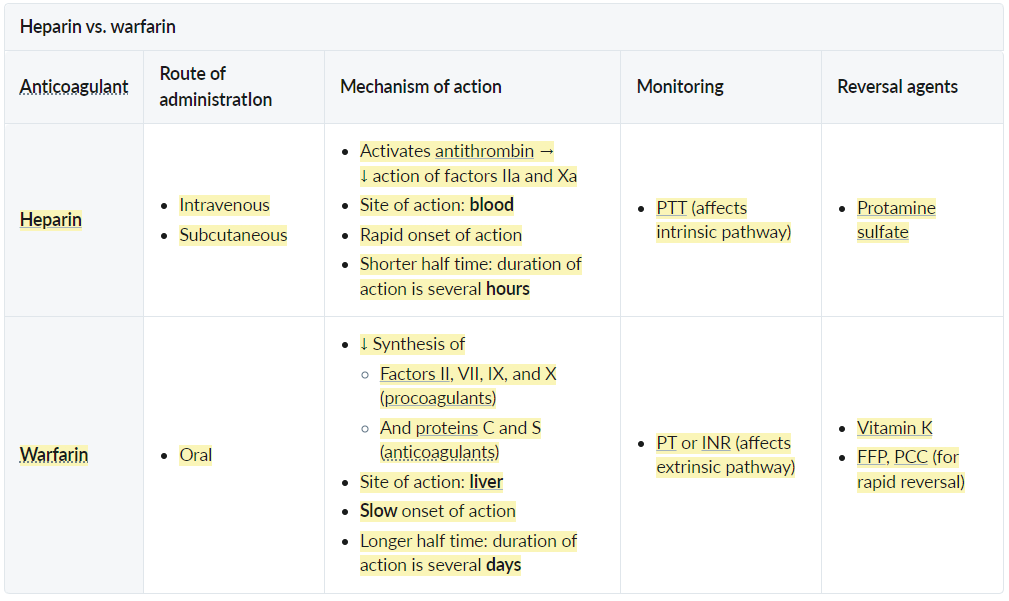Physiologic anticoagulants
- Inhibit intrinsic pathway:
- Antithrombin (with heparin): inhibit factor 2(thrombin), 9, 10, 11, 12
- Protein C: inhibit 5, 8; need VitK to synthesize
- Inhibit extrinsic pathway:
- TFPI(Tissue factor pathway inhibitor): combine factor 10 to inhibit factor 7a
Oral anticoagulants

Tip
- Heparin: also affects VIII and IX → intrinsic pathway → PTT
- Warfarin: affects both intrinsic and extrinsic pathway, but VII has shorter half life → extrinsic pathway → PT
- The half-lives of the procoagulants are ∼ 2–4 days (except for factor VII, which has a short half-life), while the anticoagulants only have half-lives of 6–10 hours.
- Intrinsic pathway remains active another 2–3 days, while extrinsic pathway and protein C are already inactive.
- Direct thrombin inhibitors: prolonged thrombin time (TT), no change to PTT or PT (not routinely monitored)
- Direct factor Xa inhibitors: prolonged PT and PTT, unchanged thrombin time (not routinely monitored)
Direct oral factor Xa inhibitors
- Mechanism & Drugs
- Direct Thrombin (IIa) Inhibitor: Dabigatran
- Factor Xa Inhibitors: Apixaban, Rivaroxaban (“-xabans”)
- Key Uses
- Prophylaxis in non-valvular Atrial Fibrillation.
- Treatment/prophylaxis of DVT / PE.
- Advantages over Warfarin
- No routine monitoring (no INR).
- Rapid onset.
- Fewer drug/diet interactions.
- Major Risks & Contraindications
- Risk: Bleeding.
- Caution: Renal impairment (esp. Dabigatran).
- Contraindication: Mechanical heart valves.
- Reversal Agents
- Dabigatran → Idarucizumab
- -xabans (Apixaban, Rivaroxaban) → Andexanet alfa
Adverse effects
Warfarin
- Warfarin-induced skin necrosis
- Seen within the first few days of treatment with high doses of warfarin
- Warfarin inhibits all vitamin K-dependent coagulation factors: anticoagulants protein C and protein S have a relatively short half-life and are depleted more quickly than procoagulants factors II, IX, and X → increased factor V and VIII activity (which protein C and S normally inactivate) → initial hypercoagulable state → formation of microthrombi → vascular occlusion, tissue infarction, and blood extravasation
- Increased risk in patients with underlying hereditary protein C deficiency
- Presentation: painful purpura, hemorrhagic blisters, and large areas of necrosis; mostly affects subcutaneous adipose tissue

- Immediate management: discontinue warfarin, administer IV vitamin K, unfractionated heparin, and source of protein C (protein C concentrate, FFP); surgical debridement and grafting in therapy-refractory cases
- Prevention: temporary bridging anticoagulation with heparin until warfarin has started to act and the initial hypercoagulable state has been bridged
Tip
Anticoagulants cause thrombosis, this can also be seen in HIT.
Warfarin reversal
Active hemorrhage (regardless of INR)
| Warfarin overdose | Heparin overdose | |
|---|---|---|
| Vitamin K | • Effective (takes days) | • Ineffective |
| FFP | • Effective (contains all blood clotting factors & proteins) | • Ineffective (contains antithrombin III → enhances heparin effect) |
| Protamine | • Ineffective | • Effective (heparin-specific antidote) |
- Stop warfarin.
- Administer IV vitamin K PLUS 4-factor prothrombin complex concentrate (PCC)
- If PCC is unavailable, give fresh frozen plasma (FFP)
- Monitor INR every 6 hours until warfarin has been fully reversed (INR ≤ 1.1)
Warfarin interactions
Warfarin is metabolized by cytochrome P450 (CYP) enzymes.
- Decrease of anticoagulant effect
- Rifampicin, carbamazepine, St. John’s wort, ginger, licorice: induce metabolic breakdown of warfarin via induction of cytochrome P450
- Foods rich in vitamin K (e.g., kale, spinach): counter effect of warfarin
- Gastric acid inhibition (PPI use), cholestyramine treatment: impaired uptake of warfarin
- Increase of anticoagulant effect
- Several antidepressants and antibiotics, PPIs, amiodarone, grapefruit: impair metabolic breakdown via inhibition of cytochrome P450
- Acetaminophen: metabolite of acetaminophen interrupts vitamin K cycle via inhibition of vitamin K-dependent carboxylase
- Sulfonamides, sulfonylureas: competitively block or displace warfarin at plasma protein binding sites
- Damage to gut flora (e.g., antibiotic therapy): impaired bacterial vitamin K synthesis
Bridging anticoagulation
- Core Concept: Using a short-acting anticoagulant (LMWH, UFH) to “bridge” the gap when a long-term oral anticoagulant (warfarin) is stopped for a procedure. Goal is to balance clot risk vs. bleeding risk.
- Who Needs Bridging? (High Thromboembolic Risk)
- Mechanical Mitral Valve (or older caged-ball/tilting disc valves)
- Recent VTE or CVA/TIA (within last 3 months)
- Atrial Fibrillation with very high risk (e.g., CHA₂DS₂-VASc ≥7, prior stroke)
- Who Does NOT Need Bridging? (Risk of bleeding > benefit)
- Most patients with Atrial Fibrillation.
- Patients on a DOAC (apixaban, rivaroxaban, dabigatran). Their short half-life means you just stop them 1-3 days before the procedure and restart after. NO BRIDGE NEEDED.
- Typical Warfarin Protocol:
- Stop Warfarin ~5 days before procedure.
- Start Bridge (e.g., LMWH) when INR is subtherapeutic (<2.0).
- Stop Bridge 24 hours (for LMWH) or 4-6 hours (for IV UFH) before procedure.
- Post-op: Restart bridge AND warfarin.
- Stop Bridge once INR is therapeutic again (≥2.0).
- Primary Complication of Bridging: ↑ Bleeding.
Parenteral anticoagulation
Unfractionated heparin (UFH)
- Antidote: protamine sulfate (a positively-charged protein that can neutralize negatively-charged heparin by forming inactive complexes)
- Can’t give fresh frozen plasma (FFP), since it contains antithrombin III → enhances heparin effect
Direct thrombin inhibitors
- Drugs: argatroban, bivalirudin, desirudin, dabigatran
- Mechanism
- Directly inhibit thrombin (freely circulating and in association with clots)
- Act independently from antithrombin
- The effect of most parenteral anticoagulants (except for direct thrombin inhibitors) works by enhancing native antithrombin III.
- Administration
- Intravenous: argatroban, bivalirudin, desirudin
- Oral: dabigatran (see direct oral thrombin inhibitors)
- Monitoring during therapy: not generally recommended
- Antidote
- Possibly aPCC and/or antifibrinolytics (e.g., tranexamic acid)
- Dabigatran: idarucizumab (monoclonal antibody)